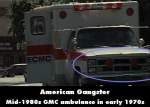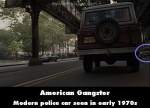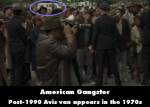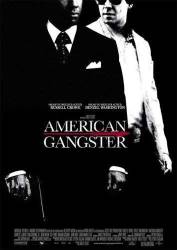
Factual error: When Frank puts coins in the pay phone, a blue label states it is a NYNEX phone. It is 1970, yet NYNEX wasn't formed until 1984. (00:20:45)

Factual error: The ambulance that the junkie cop leaps out of is a mid-1980s GMC (note the 4 square headlamps), though the film takes place in 1971. (00:35:55)
Factual error: Protesters can be seen and heard on the TV, chanting, "LBJ, how many kids did you kill today." Since the film's time frame is in the 70s, as evidenced by all the 70s cars, LBJ hadn't been the focus of the war protesters for years. (00:37:30)

Factual error: As the camera is following behind the red Bronco, at the right side of the screen a modern, white NYPD Chevy Malibu is briefly seen. (01:01:40)
Factual error: During the 1970 portion of the film, Crowe follows a guy driving a Ford Bronco. As they make a left turn, a 1973 or later Chevy Monte Carlo is parked at the curb. (01:01:40)
Factual error: As Crowe follows the man with the money bag, they cross a street and we see a white Dodge van of mid-1990s vintage parked at the curb. Note the wrap-around tail lights and the high-mounted center brake light above the rear window - a feature not on vans until after 1990. (01:01:45)
Factual error: The movie takes place in the late 1960s/early 1970s, but during Richie's pursuit of the Bronco, trains of R142 subway cars, not introduced until 2000, can be seen in the background. (01:11:15)
Factual error: In the scene where Frank Lucas drives to meet Nicky Barnes, a 2002 Lincoln town car as well as an NYPD traffic cop redirecting traffic are visible. (01:44:25 - 01:45:00)
Factual error: As Lucas is leaving the bar to make a call to Saigon, a modern blue car passes outside, seen through the curtains. (01:51:55)
Factual error: The C-130 Herc transporting the dope makes a turn towards the camera. Clearly visible on the left of the screen is a C-17 Globemaster, which was not introduced until 14th July 1993 twenty years after the scene is set. (01:56:55)
Factual error: When Russell Crowe's character is standing by his car at the end, waiting to arrest Denzel, Denzel notices there are cop cars on either side of the block. When it goes to the shot of the cop cars on his right, a modern day sedan that is tan in color passes right by the cop cars. The problem is, this film is set in the 1970s. (02:32:15)
Factual error: If you pay attention to the backgrounds of the scene where Frank is in the airport and when Frank is being arrested as he walks from the church, you can see two cars pass by which weren't produced until at least 2000.
Factual error: At the end of the film, the subtitles say that Frank was convicted and incarcerated from 1976 to 1991, which implies a continuous sentence. Lucas was actually paroled in 1981, and served a separate sentence for other drug-related offenses from 1984-91.

Factual error: In a shot in Harlem, a Ford Econoline AVIS rental truck drives on the adjacent street. The specific Econoline van was at least a mid-90's to 2000+ model van and the movie takes place in the 70s.
Factual error: In the movie one of the members of the new drug squad has a Wu-Tang Clan Tattoo on his left shoulder. (He is played by RZA of the Wu-Tang Clan). The Wu-Tang Clan was not up and running until 1993.
Factual error: The money counter used by the gangsters has a green seven-segment LED display. Although green LEDs had just been invented in the 1970's, they where way too dim and expensive to be used in commercial applications and especially seven-segment displays back then.
Factual error: In one scene, Frank talks to his nephew about missing a meeting with Billy Martin and the New York Yankees. Martin didn't become the Yankees' manager until 1975, after this scene takes place.
Factual error: When Frank goes in the Chinese place to get the car keys from his driver, he looks up the street and sees a car turning onto another street. The car looks to be a late 80s to early 90s SUV, probably a Dodge Durango, judging by the headlights and foglights.
Factual error: When a character is on a pay phone, in the background there is a sedan and two full-size vans that are from the 90s decade, not when the movie is set.
Factual error: The camera pans from the opening of the subway tunnel to Lucas' street corner, which is shown to be on the intersection of 116th Street and 8th Avenue (in green with white lettering). This is impossible, as the Manhattan Valley Viaduct, which carries the IRT Broadway-7th Avenue Line, spans from 122nd to 135th streets, and does not do so on 8th Avenue. While there is a subway line under 8th Avenue by 116th Street (IND 8th Avenue Line), it is all underground and no such opening exists. Also, the viaduct closes several blocks north of 116th street, therefore you should not see any tracks. The corner that you see is actually W 135th Street and Broadway, as the viaduct exists only on Broadway in Manhattan. Also, the signs are green with white lettering. This was not so in the 60s-70s, as in the entire borough of Manhattan during this period, street signs were yellow with black lettering.






Answer: The expensive and flashy fur coat (150,000 dollars) makes him extremely noticeable to police. Before the fight, he has been under the radar, but believes the gaudy clothes have given him away as a person with too much money, which gets the police to investigate him.